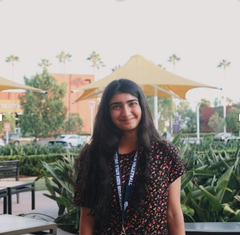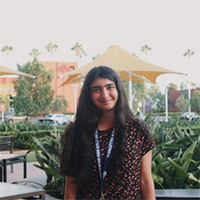Newsletters
In This Section
Page Intro text area. For AIAA to manually enter details about the latest issues - perhaps highlight cool articles or add images.
March 2020 Student in STEM - Daphne Ghazizadeh

This month’s Student in STEM is Daphne Ghazizadeh, a junior from Northwood High School in Irvine, California, and here is her story about what got her excited about STEM and showed her how important learning through experience is.
“As a young child, I’d spend hours observing the stars, enthralled by the heavens. The allure of space constantly whispered in my ear, hinting at the possibility of seeing these distant celestial spheres in person. As I grew older, I suppressed this dream due to its absurdity, but its remnants remained, tugging on my mind during quiet moments.
When I entered high school, space exploration was the last thing on my mind. The gentle twinkling of the stars was drowned out by endless homework, tests, and projects. However, this quickly changed my sophomore year, when I stumbled upon a district-wide program called CubeSat, in which students from 6 high schools work in tandem with industry professionals to launch nanosatellites into low Earth orbit. My school’s team, in particular, was responsible for the deployment of the solar array and the updating of the power budget.
After undergoing a rigorous application process, I was delighted to join the team. But then, the meetings began. Constantly bombarded by terms of which I had never heard before and complex topics unknown to me, I grew more and more confused. I felt like an outsider, unable to understand even the most basic operations. It was here that a senior wisely imparted to me that no one really knows what is happening all the time; everyone is learning through experience.
Her words transformed my viewpoint tremendously. I grew eager to learn everything I could about solar panels and nanosatellites. CubeSat became an internal competition to me with one question guiding me: what can I learn before the next meeting?
Currently, I represent my team in weekly interprogram meetings designed to create plans for possible anomalies. Sitting in a room with so many bright students, I realize that this is the future of space exploration. Sixty years ago, space was exclusive, limited to the quick-witted intellectuals of NASA. Since then, we’ve made tremendous strides in opening this field to a multitude of people. By introducing space to driven high schoolers, we, as a society, ignite a passion within them, fueling their curiosity. Through the inclusivity of space, endless progress can be made, from sending the first humans to Mars, to sending the first humans outside of our Solar System, to even sending the first humans outside of our galaxy. As long as the fire of curiosity burns within us, as long as the twinkling of stars continue to entice us, we will never stop striving for more knowledge.
Carl Sagan once said that ‘the cosmos are within us. We are all made of star stuff.’ Thus, our curiosity to explore space is really just a primordial urge to understand ourselves and our origins. As the never-ending mystique of space playfully draws us closer and closer, our curiosity can only be heightened, and our progress can only increase.”
- Students in STEM

